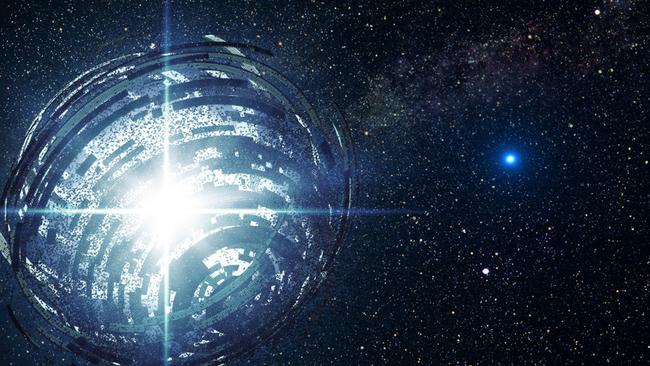Photographic ‘evidence’ of Tabby’s Star dimming over a century debunked
LAST year the world’s curiosity flared at the idea of an alien megastructure orbiting a mysterious distant star. But that theory has just been dealt an almighty blow.

NO aliens required: The mystery swirling about a strangely dimming star just got murkier. Instead of a solar-system spanning megastructure, the explanation could be more human.
In October last year the world’s curiosity flared at news the planet-hunting Kepler Space Telescope had found something odd.
Enthusiasts pouring over the masses of data collected by the telescope found something they had been dreaming about.
A telltale, seemingly random yet unexpectedly distinct flicker in a star’s light.
As early as the 1960s, it had been postulated that such a sight could be a sign of an advanced alien civilisation. The need for ever more energy to drive interstellar travel could prompt them to eventually encompass their star in a swarm of solar arrays, it was thought.
Instead of the regular, predictable eclipse caused by planets and clouds of dust, such a structure, dubbed a Dyson sphere, would likely produce a much more random — and substantial — brightening and dimming of the star from afar.
FIRST CONTACT
KIC 8462852 — nicknamed ‘Tabby’s Star’ — is a relatively common F-type star just a little bigger and hotter than our Sun. It sits in the constellation of Cygnus, some 1480 light years away.
It seemed to fit the bill.
The amateur (and professional) astronomers who make up the online Planet Hunters community had seen something unusual about Tabby’s Star when looking at a 100-day stretch of Kepler observations.
It dimmed — by up to 22 per cent of its brightness — up to a dozen times in just three months.
This was too strong, and too erratic, to explain.
SETI leapt to the fore, postulating such an advanced civilisation must also be ‘leaking’ a lot of laser and radio radiation. A search late last year found nothing.

EXPLORE MORE: What’s the fuss about this strange, stuttering star?
But a follow-up study added fuel to the fire by declaring that photographs of the star dating back to 1890 told a similar story: That the star had dimmed by an overall 20 per cent over that time.
Another study calculated this would require a cluster of 648,000 comets, each about 200km across, to move across the face of the star to create such an effect.
Naturally, this was extremely unlikely.
An alien construction project proceeding at such an enormous rate to achieve the same effect seemed only slightly less so.
But the Dyson sphere idea — in the absence of anything else — seemed to gain traction.
SCIENCE, IT’S SURVIVAL OF THE FITTEST
Inspired by Louisiana State University’s study of old photographic plates, researchers looked elsewhere to find more.
More than 50,000 glass-plate photographs had been assembled by Harvard University between 1885 and 1993. Its recent digitisation under the DASCH (Digital Access to a Sky Century @ Harvard) project presented an opportunity to verify — or otherwise — Schaefer’s observations.
First indications were not promising.
Many stars seemed to record a drop in brightness over the course of the past century.
“That indicates the drops were caused by changes in the instrumentation, not by changes in the stars’ brightness,” study co-author Keivan Stassun of Vanderbilt University said in a statement.
The dimming now seems likely to have been caused by the gradual deterioration of the equipment — including the cameras and their lenses — used to record and print these photographic glass plates.
SO WHAT’S WITH THE STUTTERING STAR?
It’s still stuttering. Science still doesn’t know why.
It’s just that the notion of the rapid construction of a solar-system spanning alien megastructure has taken a body blow.
And the alternatives are beginning to narrow.
Another recently released study has shown little evidence of the infrared signature of dust billowing about the star. This weakens the idea that a collision among planets in its solar system was behind the weird ‘blinking’.
This leaves the idea that a nearby ‘wandering’ star having kicked up a cloud of enormous comets from the Oort Cloud (a distant region full of icy leftovers from the star’s creation) as the strongest remaining possibility.
But the attention of astronomers around the world remains firmly fixed on KIC 8462852.
It’s being watched with a whole range of instruments to deconstruct each dip in brightness — pulling apart its colour spectrum in the hope of finding clues as to what may be getting in the way.




